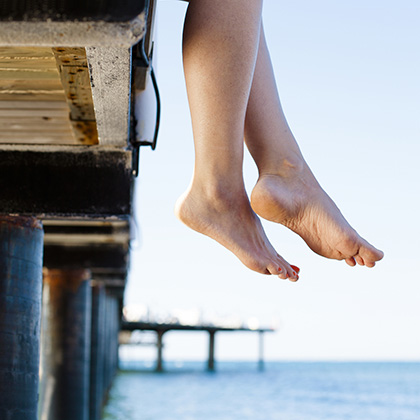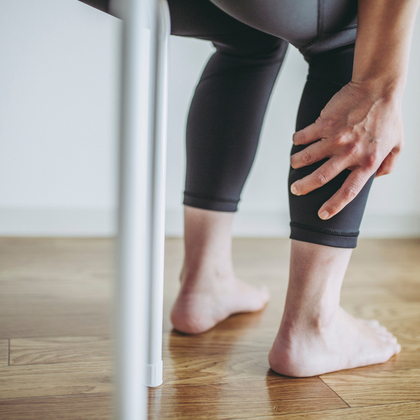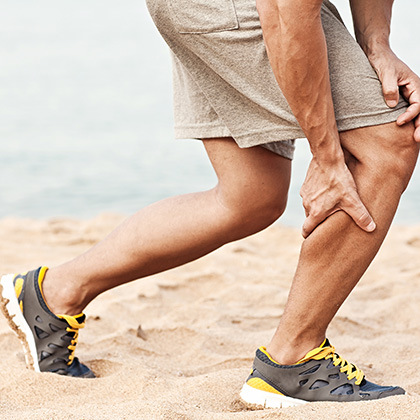If you have a red, itchy rash between your toes where the skin is also peeling, blistered, scaly or cracked, chances are you have athlete’s foot (tinea pedis).
Experts claim athlete’s foot – which is a fungal infection of the skin on the feet – is very common, with up to one in four people affected (i). And the reason it’s called athlete’s foot is it often affects people who use communal showers at the gym and other sporting facilities, as well as those who walk barefoot in changing rooms and around swimming pools.
With athlete’s foot, tiny flakes of infected skin can fall off. If someone else walks on one of the infected skin flakes with no shoes or socks on – easily done in a communal shower or changing room – they can go on to develop the infection themselves. It can also be spread easily if you use a towel that someone with athlete’s foot has used before you.
According to the UK’s College of Podiatry, athlete’s foot can be passed on directly from person-to-person contact too (ii). People who sweat more are also much more likely to become infected. Occasionally it may be that range of other foot problems could be contributing towards the development of athlete’s foot.
The first sign is usually a rash that becomes itchy and scaly, most often between the fourth and fifth toes. Then the affected skin may become cracked and sore, with large painful splits in the skin developing between the toes. If left untreated, the infection can spread along all five toes and also to your toenails, potentially causing fungal nail infections. It can also spread elsewhere – including your scalp, hands and groin – if you scratch infected skin and then touch another part of your body.
The infection itself isn’t usually serious, but it can make you feel very uncomfortable. And if it’s allowed to spread, it can be much harder to treat. Also other bacteria can cause a much more serious infection called cellulitis if they get into the cracked skin of untreated athlete’s foot.
What causes it?
The type of fungi that cause athlete’s foot are called dermatophytes. These fungi love moist, warm, airless conditions – such as the damp environment of shoes or trainers – and feed on a protein found in hair, nails and skin called keratin. However, the infection can also develop in dry, flaky areas (during the summer months, many people who wear sandals a lot develop athlete’s foot because the sun makes the skin on their feet dry).
In general, you’re more likely to get athlete’s foot if you’re affected by any of the following:
-
Your feet aren’t always clean and dry.
-
You wear shoes that make your feet hot and sweaty.
-
You walk barefoot around gyms, communal showers and changing rooms.
-
You share towels, socks and shows with other people.
If you have a weakened immune system or a health condition such as diabetes, you may also be more likely to have athlete’s foot.
Treatments for athlete’s foot
Athlete’s foot can be a stubborn infection to treat if you don’t tackle it correctly and as soon as possible. This is why experts advise treating it as soon as you notice any itchiness between your toes.
The conventional way to treat athlete’s foot is to use topical antifungal products that you can buy over the counter at pharmacies. These are usually creams, but you can also find sprays, liquids and powders. There are various types available, and according to experts there’s no evidence that any is better than the other.
These treatments are based on one of the following antifungal medications, which should be used as the instructions advise:
-
Clotrimazole (usually applied 2 - 3 times a day for at least four weeks).
-
Terbinafine (1 - 2 times a day for seven days).
-
Econazole (twice a day until the skin is back to normal).
-
Ketoconazole (twice a day for seven days, treat for longer if the infection is more severe).
-
Miconazole (twice a day and treat for a further 10 days after the skin is back to normal).
-
Undecenoic acid (twice a day and treat for a further week after the skin is back to normal).
Some of these treatments aren’t suitable for children, older people and pregnant or breastfeeding women. So check with a pharmacist before you buy.
How to use antifungal treatments
Antifungal medicines work by preventing the growth of the fungi, and are often recommended to be used even after the rash has cleared to make sure all of the infection has been killed off. Always read the instructions that come with the product.
You should also make sure your skin is clean and dry before applying any antifungal treatment. According to the College of Podiatry, you should try to wash your feet in cold water first – the colder the better, since heat encourages the growth of the fungi (ii). Then dab your feet dry thoroughly using a clean towel or even kitchen roll (don’t rub them dry, as this can damage any skin that’s healing).
Once you have washed and dried your affected foot or feet and applied your treatment, wash your hands and any towels you may have used thoroughly.
If your infection doesn’t clear up after using an over-the-counter treatment or if it’s severe, your GP can write you a prescription for antifungal tablets.
Most importantly, while your athlete’s foot is being treated, try to keep your feet covered whenever you use a gym or communal changing areas to try to prevent the infection being spread to other people.
Preventing athlete’s foot
According to the College of Podiatry, the single most important tip for preventing athlete’s foot is to make sure your feet are completely dry after washing them – including between the toes – and before you put your shoes and socks on (ii).
There are several other things you can do to help prevent the infection, including the following:
-
After you’ve washed your feet, don’t moisturise between your toes, as it can help fungi multiply. Try using talcum powder on your feet to stop them getting sweaty, but again avoid getting powder between your toes as it can irritate the skin.
-
Don’t wear the same shoes every day, change them regularly so that they have time to dry out properly (this takes around 24-48 hours). Also wear clean socks every day, and never wear shoes, trainers or slippers that have been worn by someone else.
-
Try drying your shoes with a hairdryer on a cold setting if you can’t avoid wearing them two days in a row. The cold air will dry out any perspiration without making your shoes even hotter. Unfasten any buckles, laces or straps to allow your shoes to dry out more quickly.
-
When buying trainers, look for pairs that have holes or mesh fabrics that allow ventilation.
-
Choose shoes that allow your toes to stretch out – if they’re so tight that your toes are squashed together, it creates moisture, which encourages the growth of fungi. Also try to choose shoes made from natural materials rather than synthetic ones, as synthetic materials can make your feet sweat more. Dusting your shoes with antifungal powder may also help keep an infection at bay.
-
Always wear flip-flops or pool sandals in public and communal places, such as showers, baths, swimming pools, changing rooms and gyms. This is also important if you already have athlete’s foot, as it will help prevent the spread of the infection to others.
-
Don’t share towels with anyone else, especially in communal places, and make sure towels at home are washed frequently (if you already have athlete’s foot, wash your towels at the hottest possible water setting).
-
Try to let the air get to your feet as often as possible when you’re at home by leaving your shoes and socks off whenever it’s convenient.
Other types of fungal infections
The medical term for fungal infections is tinea, and athlete’s foot (tinea pedis) isn’t the only type. Other types of tinea fungal infection include ringworm (tinea corporis), fungal scalp infection (tinea capitis), jock itch (tinea cruris) and fungal nail infection (tinea unguium or onychomycosis).
Ringworm
This fungal infection can affect almost any part of the body but often affects the arms and legs. It doesn’t have anything to do with worms, but gets its name from the pattern of the rash, which is red or silvery and ring-like.
The skin around the ring can look irritated and may feel scaly, itchy and inflamed. Inside the ring, however, the skin looks and feels normal. Unless the rash is treated, the rings can multiply and get bigger, and blisters and sores may form around them.
As with athlete’s foot, ringworm is treated with over-the-counter antifungal creams, gels or sprays.
Fungal scalp infection
If you have small, sore patches of scaly skin on your scalp, you may have a fungal scalp infection. Other symptoms include an itchy scalp, patches of hair loss with broken hairs at the surface and – in more severe cases, small sores and crusting on the scalp and more noticeable bald patches.
If you have a fungal scalp infection, you should see your GP for prescription medication, including an antifungal shampoo and antifungal tablets.
Jock itch
As the name implies, this type of fungal infection affects the groin area, most commonly in men. It can cause itchiness and redness around the groin area, as well as flaky skin on the inside of your thighs. You may also have blisters or sores around the edge of the rash.
Wearing tight clothing or underwear can make jock itch worse, as can exercising and walking. Treatment includes antifungal creams, gels and sprays.
Some people can get fungal groin infections at the same time as athlete’s foot. If you don’t treat both infections at the same time, you can be reinfected by one of them.
Fungal nail infection
Symptoms of this type of fungal infection include a nail that has become thick, discoloured (either white, black, yellow or green) or brittle, with the skin around the nail feeling sore and irritated. Click here for more information on treatments for fungal nail infections as well as how to keep your nails healthy.
Fungal infections can also affect the hands (tinea manuum) and beard area in men (tinea barbae).
Natural relief for athlete’s foot
While antifungal medicines are the mainstay of conventional athlete’s foot treatments, there are also some natural remedies that may be useful:
Tea tree oil
There’s been a long traditional use of tea tree oil (Melaleuca alternifolia) in Australia for skin and other skin infections, with studies suggesting it has potent antiseptic properties that are active against a range of bacteria and fungi (iii).
One study that included 158 people with athlete’s foot found tea tree oil is more effective than placebo at killing the infection (25% and 50% solutions of tea tree oil were used in the study, both were found to be effective, with the 50% solution the more effective of the two) (iv).
To try it yourself, soak your feet in a bowl of warm water with 20 drops of tea tree oil for 10 minutes, three times a day. You can also apply undiluted tea tree oil to your skin. But if you find it irritates your skin, dilute the tea tree oil in a carrier oil such as grapeseed oil first. Remember to always dry your feet thoroughly after soaking them.
Garlic
Studies into the properties of garlic suggest this plant has antifungal properties (v). You can add lots of garlic to your diet, or you may prefer to take garlic tablets. There’s also evidence to suggest cream containing a compound derived from garlic, called ajoene, may be beneficial in the treatment of athlete’s foot (vi).
Vitamin C
A high-strength vitamin C tablet may also help support your immune system while you’re treating a bout of athlete’s foot, thanks to the vitamin’s antioxidant properties.
For even more information on a range of skin conditions, as well as other common health concerns, visit our health library.
References:
-
Available online: https://patient.info/infections/fungal-infections/athletes-foot-tinea-pedis
-
Available online: https://cop.org.uk/foot-health/common-foot-problems/athletes-foot/
-
Williams. LR, Home. VN, et al. The composition and bactericidal activity of oil of Melaleuca alternifolia (Tea tree oil). Int J Aromather. 1989;1:15-17.
-
May. J, Chan. CH, King. A, et al. Time-kill studies of tea tree oils on clinical isolates J Antimicrob Chemother. 2000;45:639-643. Available online: https://pubmed.ncbi.nlm.nih.gov/10797086-time-kill-studies-of-tea-tree-oils-on-clinical-isolates/
-
Satchell. AC, Saurajen. A, Bell. C, Barnetson. RS, et al. Treatment of interdigital tinea pedis with 25% and 50% tea tree oil solution: a randomized, placebo-controlled, blinded study. Australas J Dermatol. 2002;43:175-178.
-
Hughes. BG, Lawson. LD. Antimicrobial effects of Allium sativum (garlic), Allium ampeloprasum L (elephant garlic), and Allium cepa (onion), garlic compounds and commercial garlic supplement products. Phytother Res. 1991;5:154-158. Available online: https://onlinelibrary.wiley.com/doi/abs/10.1002/ptr.2650050403
-
Ledezma .E, DeSousa. L, Jorquera. A, et al. Efficacy of ajoene, an organosulphur derived from garlic, in the short-term therapy of tinea pedis. Mycoses. 1996;39:393-395. Available online: https://pubmed.ncbi.nlm.nih.gov/9009665-efficacy-of-ajoene-an-organosulphur-derived-from-garlic-in-the-short-term-therapy-of-tinea-pedis/
-
Ledezma. E, Marcano. K, Jorquera. A, et al. Efficacy of ajoene in the treatment of tinea pedis: a double-blind and comparative study with terbinafine. J Am Acad Dermatol. 2000;43:829-832. Available online: https://pubmed.ncbi.nlm.nih.gov/11050588-efficacy-of-ajoene-in-the-treatment-of-tinea-pedis-a-double-blind-and-comparative-study-with-terbinafine/
Related Posts
Disclaimer: The information presented by Nature's Best is for informational purposes only. It is based on scientific studies (human, animal, or in vitro), clinical experience, or traditional usage as cited in each article. The results reported may not necessarily occur in all individuals. Self-treatment is not recommended for life-threatening conditions that require medical treatment under a doctor's care. For many of the conditions discussed, treatment with prescription or over the counter medication is also available. Consult your doctor, practitioner, and/or pharmacist for any health problem and before using any supplements or before making any changes in prescribed medications.

Christine
Christine Morgan has been a freelance health and wellbeing journalist for almost 20 years, having written for numerous publications including the Daily Mirror, S Magazine, Top Sante, Healthy, Woman & Home, Zest, Allergy, Healthy Times and Pregnancy & Birth; she has also edited several titles such as Women’ Health, Shine’s Real Health & Beauty and All About Health.
View More



